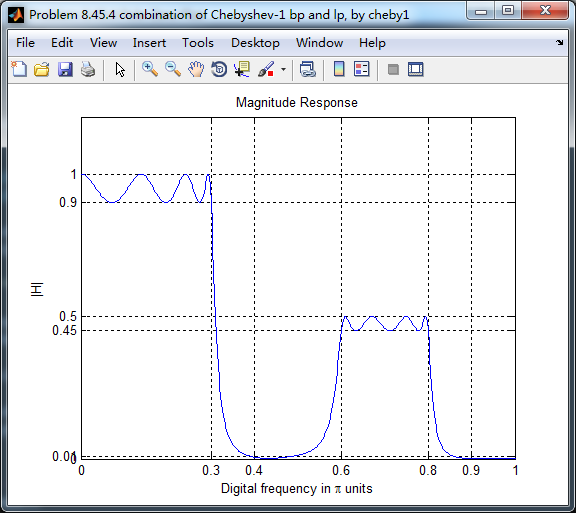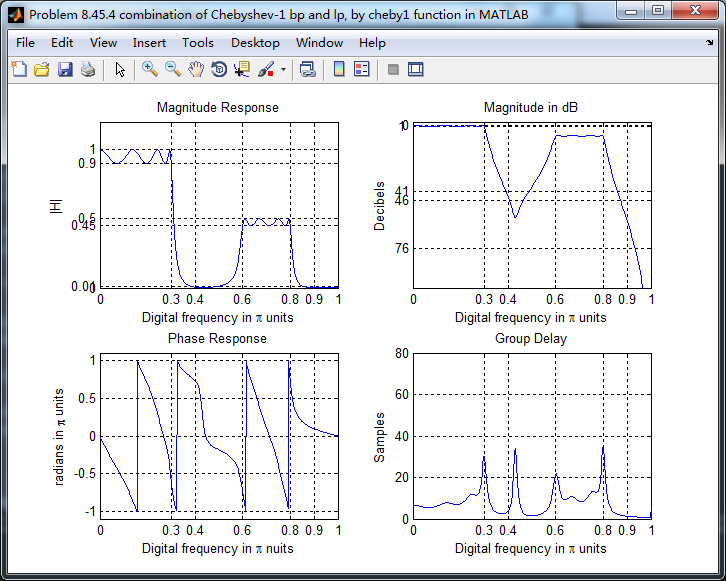

代码:
%% ------------------------------------------------------------------------
%% Output Info about this m-file
fprintf('
***********************************************************
');
fprintf(' <DSP using MATLAB> Problem 8.45.4
');
banner();
%% ------------------------------------------------------------------------
%%
%% Chebyshev-1 bandpass and lowpass, parallel form,
%% by toolbox function in MATLAB,
%%
%% ------------------------------------------------------------------------
%--------------------------------------------------------
% PART1 bandpass
% Digital Filter Specifications: Chebyshev-1 bandpass
% -------------------------------------------------------
wsbp = [0.40*pi 0.90*pi]; % digital stopband freq in rad
wpbp = [0.60*pi 0.80*pi]; % digital passband freq in rad
delta1 = 0.05;
delta2 = 0.01;
Ripple = 0.5-delta1; % passband ripple in absolute
Attn = delta2; % stopband attenuation in absolute
Rp = -20*log10(Ripple/0.5); % passband ripple in dB
As = -20*log10(Attn/0.5); % stopband attenuation in dB
% Calculation of Chebyshev-1 filter parameters:
[N, wn] = cheb1ord(wpbp/pi, wsbp/pi, Rp, As);
fprintf('
********* Chebyshev-1 Digital Bandpass Filter Order is = %3.0f
', 2*N)
% Digital Chebyshev-1 Bandpass Filter Design:
[bbp, abp] = cheby1(N, Rp, wn);
[C, B, A] = dir2cas(0.5*bbp, abp)
% Calculation of Frequency Response:
[dbbp, magbp, phabp, grdbp, wwbp] = freqz_m(0.5*bbp, abp);
% -----------------------------------------------------
% PART2 lowpass
% Digital Highpass Filter Specifications:
% -----------------------------------------------------
wslp = 0.40*pi; % digital stopband freq in rad
wplp = 0.30*pi; % digital passband freq in rad
delta1 = 0.10;
delta2 = 0.01;
Ripple = 1.0-delta1; % passband ripple in absolute
Attn = delta2; % stopband attenuation in absolute
Rp = -20*log10(Ripple/1.0); % passband ripple in dB
As = -20*log10(Attn/1.0); % stopband attenuation in dB
% Calculation of Chebyshev-1 filter parameters:
[N, wn] = cheb1ord(wplp/pi, wslp/pi, Rp, As);
fprintf('
********* Chebyshev-1 Digital Lowpass Filter Order is = %3.0f
', N)
% Digital Chebyshev-1 lowpass Filter Design:
[blp, alp] = cheby1(N, Rp, wn);
[C, B, A] = dir2cas(blp, alp)
% Calculation of Frequency Response:
[dblp, maglp, phalp, grdlp, wwlp] = freqz_m(blp, alp);
% ---------------------------------------------
% PART3 parallel form of bp and lp
% ---------------------------------------------
abp;
bbp;
alp;
blp;
fprintf('
********* Chebyshev-1 Digital Lowpass parrell with Bandpass Filter *******
');
fprintf('
********* Coefficients of Direct-Form: *******
');
a = conv(2*abp, alp)
b = conv(bbp, alp) + conv(blp, 2*abp)
[C, B, A] = dir2cas(b, a)
% Calculation of Frequency Response:
[db, mag, pha, grd, ww] = freqz_m(b, a);
%% -----------------------------------------------------------------
%% Plot
%% -----------------------------------------------------------------
figure('NumberTitle', 'off', 'Name', 'Problem 8.45.4 combination of Chebyshev-1 bp and lp, by cheby1 function in MATLAB')
set(gcf,'Color','white');
M = 1; % Omega max
subplot(2,2,1); plot(ww/pi, mag); axis([0, M, 0, 1.2]); grid on;
xlabel('Digital frequency in pi units'); ylabel('|H|'); title('Magnitude Response');
set(gca, 'XTickMode', 'manual', 'XTick', [0, wplp/pi, wsbp(1)/pi, wpbp/pi, wsbp(2)/pi, M]);
set(gca, 'YTickMode', 'manual', 'YTick', [0, 0.01, 0.45, 0.5, 0.9, 1]);
subplot(2,2,2); plot(ww/pi, db); axis([0, M, -100, 2]); grid on;
xlabel('Digital frequency in pi units'); ylabel('Decibels'); title('Magnitude in dB');
set(gca, 'XTickMode', 'manual', 'XTick', [0, wplp/pi, wsbp(1)/pi, wpbp/pi, wsbp(2)/pi, M]);
set(gca, 'YTickMode', 'manual', 'YTick', [-76, -46, -41, -1, 0]);
set(gca,'YTickLabelMode','manual','YTickLabel',['76'; '46'; '41';'1 ';' 0']);
subplot(2,2,3); plot(ww/pi, pha/pi); axis([0, M, -1.1, 1.1]); grid on;
xlabel('Digital frequency in pi nuits'); ylabel('radians in pi units'); title('Phase Response');
set(gca, 'XTickMode', 'manual', 'XTick', [0, wplp/pi, wsbp(1)/pi, wpbp/pi, wsbp(2)/pi, M]);
set(gca, 'YTickMode', 'manual', 'YTick', [-1:0.5:1]);
subplot(2,2,4); plot(ww/pi, grd); axis([0, M, 0, 80]); grid on;
xlabel('Digital frequency in pi units'); ylabel('Samples'); title('Group Delay');
set(gca, 'XTickMode', 'manual', 'XTick', [0, wplp/pi, wsbp(1)/pi, wpbp/pi, wsbp(2)/pi, M]);
set(gca, 'YTickMode', 'manual', 'YTick', [0:20:80]);
figure('NumberTitle', 'off', 'Name', 'Problem 8.45.4 combination of Chebyshev-1 bp and lp, by cheby1')
set(gcf,'Color','white');
M = 1; % Omega max
%subplot(2,2,1);
plot(ww/pi, mag); axis([0, M, 0, 1.2]); grid on;
xlabel('Digital frequency in pi units'); ylabel('|H|'); title('Magnitude Response');
set(gca, 'XTickMode', 'manual', 'XTick', [0, wplp/pi, wsbp(1)/pi, wpbp/pi, wsbp(2)/pi, M]);
set(gca, 'YTickMode', 'manual', 'YTick', [0, 0.01, 0.45, 0.5, 0.9, 1]);
figure('NumberTitle', 'off', 'Name', 'Problem 8.45.4 Pole-Zero Plot')
set(gcf,'Color','white');
zplane(b, a);
title(sprintf('Pole-Zero Plot'));
%pzplotz(b,a);
运行结果:
看题目设计要求,是Chebyshev-1型低通和带通的组合。
我们先设计带通,系统函数串联形式的系数如下:

其次,Chebyshev-1型数字低通,阶数为7,系统函数串联形式的系数如下:

再次,低通和带通进行组合,等效滤波器的系统函数,直接形式和串联形式,系数分别如下:


等效滤波器,幅度谱如下,频带边界频率和指标画出直线,

幅度谱、相位谱和群延迟响应

零极点图
